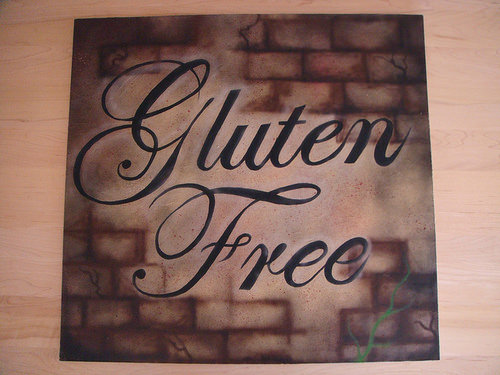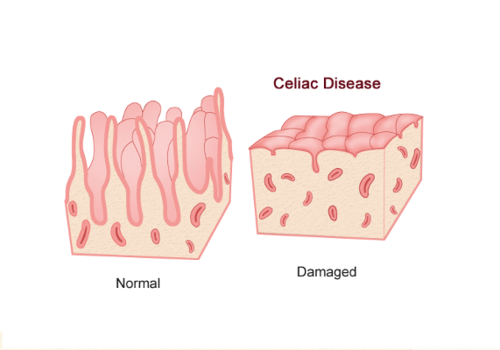17.1 案例研究:食品加工
章节大纲
-
Case Study: Please Don’t Pass the Bread
::案例研究:请不要通过面包Angela and Mariah are college students who met in physics class. They decide to study together for their upcoming midterm, but first, they want to grab some lunch. Angela says there is a particular restaurant she would like to go to, because they are able to accommodate her dietary restrictions. Mariah agrees and they head to the restaurant.
::Angela和Mariah是大学生,在物理课上相遇。他们决定一起学习即将到来的中期,但首先,他们想一起吃午餐。Angela说她想去一家餐厅,因为他们可以满足她的饮食限制。Mariah同意,他们去餐厅。At lunch, Mariah asks Angela what is special about her diet. Angela tells her that she can’t eat gluten. Mariah says, “My cousin did that for a while because she heard that gluten is bad for you. But it was too hard for her to not eat bread and pasta, so she gave it up.” Angela tells Mariah that avoiding gluten isn’t optional for her — she has celiac disease. Eating even very small amounts of gluten could damage her .
::在午餐时,玛利亚问安吉拉她的饮食有什么特殊之处。 安吉拉告诉她她不能吃谷类。 玛利亚说 , “ 我表弟这样做有段时间是因为她听说谷类对你不好。 但是,她很难不吃面包和意大利面,因此她放弃了。 ”安吉拉告诉玛利亚,避免谷类对她来说不是可选择的 — — 她得了宫颈病。 吃了很少量的谷类会伤害她。You have probably heard of gluten, but what is it, and why is it harmful to people with celiac disease? Gluten is a present in wheat and some other grains (such as barley, rye, and oats), so it is commonly found in foods like bread, pasta, baked goods, and many packaged foods. For people with celiac disease, eating gluten causes an autoimmune reaction that results in damage to the small, finger-like villi lining the , causing them to become inflamed and flattened (see illustration ). This damage interferes with the digestive process, which can result in a wide variety of symptoms including diarrhea, anemia, skin rash, pain, depression, and anxiety, among others. The degree of damage to the villi can vary from mild to severe, with more severe damage generally resulting in more significant symptoms and complications. Celiac disease can have serious long-term consequences, such as osteoporosis, problems in the nervous and reproductive systems, and the of certain types of cancers.
::你可能听说过谷质,但是它是什么,它为什么有害于病患者?Gluten是小麦和一些其他谷物(如大麦、黑麦和燕麦)的产物,因此通常在面包、意大利面、面包食品和许多包装食品等食品中发现。对于患有病的人来说,吃谷质会引起自动免疫反应,导致小的、像手指一样的葡萄糖衬里损伤,导致他们发炎和扁扁(见插图 ) 。这种损害会干扰消化过程,这可能造成各种各样的症状,包括腹泻、贫血、皮疹、疼痛、抑郁和焦虑等。对葡萄酒的损害程度可能从轻到重不等,通常会造成更严重的症状和并发症。Celiac疾病可以产生严重的长期后果,如骨质疏松症、神经和生殖系统问题,以及某些癌症类型。How celiac disease can affect the villi of the small intestine
::切片病如何影响小肠子的葡萄酒Why does celiac disease cause so many different types of symptoms and have such significant negative health consequences? As you read this chapter and learn about how the digestive system works, you will see just how important the villi of the small intestine are to the body as a whole. At the end of the chapter, you will learn more about celiac disease, why it can be so serious, and whether it is worth avoiding gluten for people who do not have a diagnosed medical issue with it.
::切片疾病为什么引起如此多不同类型的症状和如此严重的负面健康后果? 当你阅读本章并了解消化系统如何运作时,你会看到小肠的葡萄酒对整个身体的重要性。 在章末,你会更多地了解切片疾病,为什么它会如此严重,以及对于没有诊断出病症的人来说是否值得避免营养质。Chapter Overview: Digestive System
::章节概览:消化系统In this chapter, you will learn about the digestive system, which processes food so that our bodies can obtain nutrients . Specifically, you will learn about:
::在本章中,你们将了解消化系统,它处理食物,以便我们的身体获得营养。具体地说,你们将了解:-
The structures and
organs
of the gastrointestinal (GI) tract through which food directly passes. This includes the mouth,
pharynx
,
esophagus
,
stomach
, small intestine, and
.
::食物直接经过的胃肠道的结构和器官,包括口腔、阴道、食道、胃、小肠和。 -
The functions of the GI tract, including mechanical and
chemical digestion
,
absorption
of nutrients, and the
elimination
of solid waste
::GI大片的功能,包括机械和化学消化、吸收养分和消除固体废物 -
The
accessory organs
of
digestion
— the
liver
,
gallbladder
, and
pancreas
— which secrete substances needed for digestion into the GI tract, in addition to performing other important functions
::消化的辅助器官——肝脏、胆囊和胰腺——除了发挥其他重要功能外,还把消化所需的物质分泌到GI道中去 -
Specializations of the
tissues
of the digestive system that allow it to carry out its functions
::消化系统组织专门化,使其能够履行职能 -
How different
(such as
, proteins, and fats) are digested and absorbed by the body
::身体如何消化和吸收不同(如蛋白质和脂肪) -
Beneficial
that live in the GI tract and help us digest food, produce
vitamins
, and protect us from harmful
and toxic substances
::帮助我们消化食物,生产维生素,保护我们免受有害和有毒物质的危害。 -
Disorders of the digestive system, including inflammatory bowel diseases,
ulcers
, diverticulitis, and gastroenteritis (commonly known as “stomach flu”)
::消化系统紊乱,包括炎性肠道疾病、溃疡、分流性肺炎和胃肠炎(俗称“口腔炎”)
As you read this chapter, think about the following questions related to celiac disease:
::当你读到本章时,请考虑以下有关结肠病的问题:1. What are the general functions of the small intestine? What do the villi in the small intestine do?
::1. 小肠子的一般功能是什么?小肠子的葡萄酒是做什么的?2. Why do you think celiac disease causes so many different types of symptoms and potentially serious complications?
::2. 为什么你认为宫颈病造成如此多种类的症状和潜在的严重并发症?3. What are some other that involve the body attacking its own digestive system?
::3. 涉及人体攻击其自身消化系统的其他什么? -
The structures and
organs
of the gastrointestinal (GI) tract through which food directly passes. This includes the mouth,
pharynx
,
esophagus
,
stomach
, small intestine, and
.

